Most animals live on the ground or underwater. But what animals live in trees? Tree-dwelling animals do almost everything in the trees: feeding, sleeping, and raising their young.
We’ll focus on 26 animals that live in trees. They include flying dragon lizards, white bats, silky anteaters, pandas, and gibbons. Most have adapted to make their tree living successful.
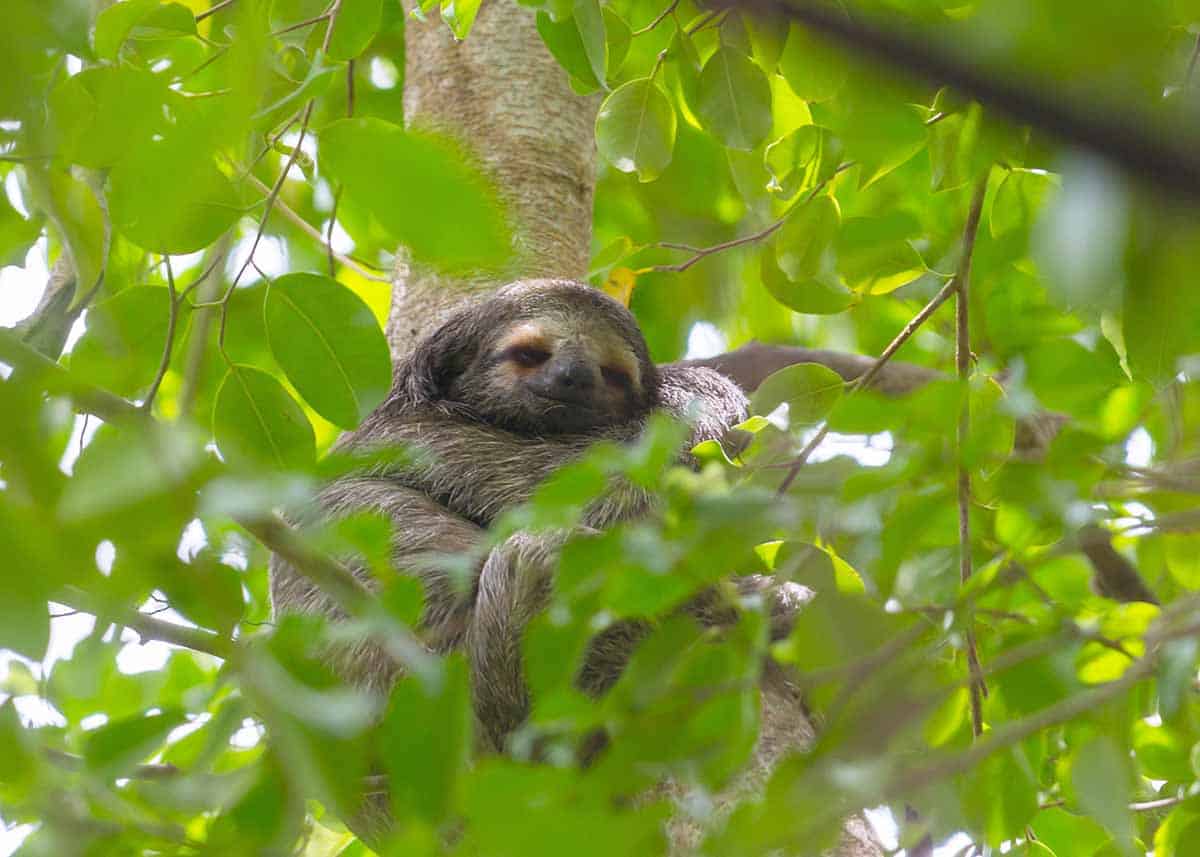
Table of Contents
25 Animals That Live in Trees
Living in trees presents many challenges. They include mobility, gathering food, shelter, and caring for their young.
These animals that live in trees have significant adaptations to help them be successful.
1. Koalas
Koalas spend much of their time feeding and sleeping among tree branches. These Australian native tree dwellers rely primarily on moisture from eucalyptus leaves to achieve their hydration needs.
Though they are arboreal animals, they must climb to the ground to move between trees.
Koalas are one of the most famous marsupial species. Learn about all 334 Animals with Pouches
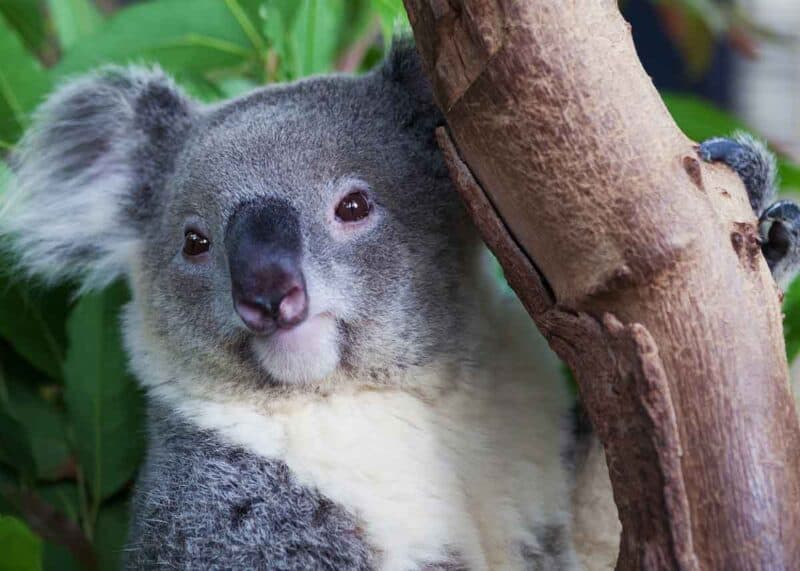
2. Flying Squirrels
Flying squirrels are scientifically known as Pteromyini or Petauristini. There are more than 50 squirrel species belonging to the Sciuridae family.
They use their patagium to glide from one tree to another. They further use their tail and limbs to control and direct their glide.
Flying squirrels are lighter and smaller than other squirrels. Because of their ability to glide between trees, they spend very little time on the ground.
3. Tree Frog (Flying Frogs)
Flying frogs can glide but not actually fly. They can descend from a tree at a 45-degree or less angle.
This species has several adaptation features, including:
- Lower weight per foot length
- Lateral skin flaps on legs and arms
- Fully webbed feet between toes and fingers
- Enlarged hands and feet
Italian tree frogs are native to Italy and have adapted to living in trees within that region. You can quickly identify them using their bright green color and the dark line contrasting their body texture.
Their colors allow perfect camouflage on leafy branches, while their sticky fingers enable them to climb trees easily.
4. Orangutan
Orangutans are the world’s largest tree-climbing mammals. The name orangutan itself means “man of the forest.”
To make their stay in trees more comfortable, orangutans make nests of trees and vegetation to rest during the day and sleep at night.
5. Silky Anteater
Silky anteaters are the smallest anteaters and have shorter faces than other species. Their silken skin is attributed to their living in the silk-cotton trees, mainly in South and Central America.
Silky anteaters spend nearly their entire lives in trees. Their long, prehensile tails enable them to navigate life in the trees.
6. Honduran White Bat
Honduran white bats are small and adorable. They are sometimes called Furby or marshmallow puff bats.
This species is found in Central and South America. They populate around areas where fig trees are present, usually around 0-700 meters above sea level.
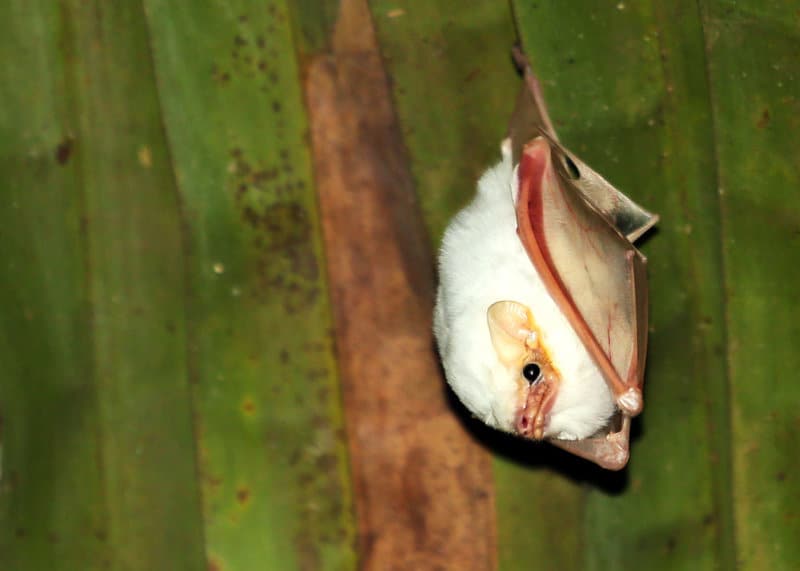
7. Gibbon
Gibbons are renowned as the most agile among all the tree-dwelling non-flying mammals. They have athletic bodies that perfectly adapt them to live in trees.
They have reduced thumbs and long arms, which allow them to cup branches.
Don’t mistake gibbons for monkeys. They’re apes and are more closely related to orangutans, gorillas, and chimpanzees.
8. Giant Panda
Giant pandas love subsisting almost entirely on bamboo. That’s why they live mainly in the bamboo forests on the mountaintops of western China.
While in this ecosystem, giant pandas play a significant role in seed dispersal and facilitation of vegetation growth.
9. Binturong
Binturong is scientifically known as Arctictis binturong. It’s a viviparous species native to various Asian forests.
It’s the largest mammal in its group, weighing an average of 15 kg. They climb the tree skillfully, albeit slowly, since they’re not nimble.
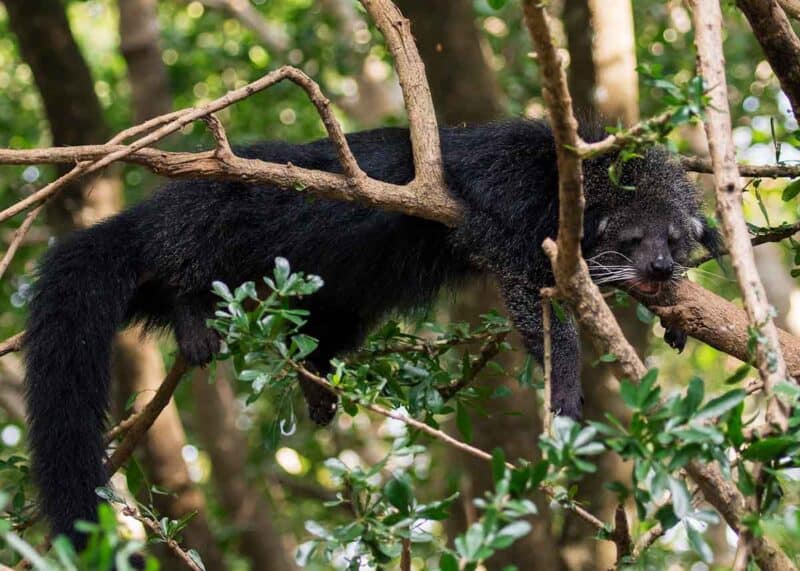
10. Tree Kangaroos
Tree kangaroos live in the lowland and mountain rainforests in:
- Australia
- Indonesia
- Papua New Guinea
They have shorter legs and longer forelimbs for climbing, which makes them adapted to life in trees. These animals are Australia’s largest tree-dwelling mammals.
Tree kangaroos don’t sweat. Instead, they lick their forearms to allow room for evaporation and a subsequent cool of their bodies.
Here are other ways animals keep cool.
11. Spider Mite
Spider mites significantly affect trees while living on them. They tend to leave brown and yellow dots on the leaves.
An adult spider mite can lay approximately 100 eggs on the underside of tree leaves in three weeks.
12. Allomerus decemarticulatus
Allomerus decemarticulatus is a species of ant living in the tropics of South America. These ants’ diet consists of giant insects that prey on plants.
Additionally, they feed on plant nectars. These ants build a platform that serves as a trap for their unsuspecting prey. They hide on the web and attack their target once it lands there.
13. Birch Leaf Miner
Birch leaf miners are commonly associated with the birch trees. These European native tree dwellers interestingly have their larvae dwelling inside the tree leaves.
Birch leaf miners feed on the soft inner plant tissues found between each leaf’s lower and upper sides. The leaf surface provides excellent protection, so chemical sprays do not easily kill them.
14. Bark Beetle
You’ll find bark beetles in dry trees. They aid in the nutrient cycle, enabling the tree to thrive.
Adult bark beetles infest the tree by chewing through the tree’s outer bark. They also create networks of cavities or tunnels under tree backs for mating and laying eggs.
15. Flying Dragon
Flying dragons, also known as draco (or Draco volans), are serious tree dwellers. Other than when they descend to the floor to lay eggs, flying dragons spend the rest of their time on tree tops.
Their distinct ecosystems are tropical rainforests.
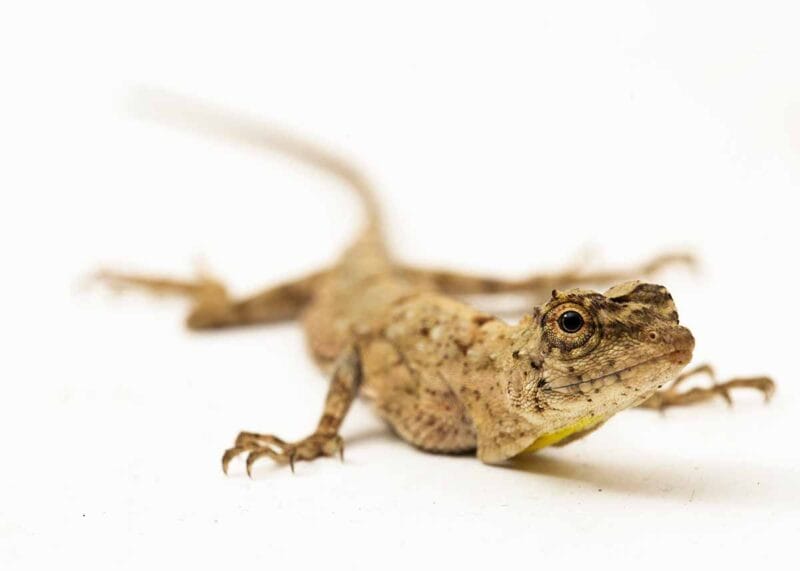
16. Green Iguana
The green iguana is a colossal lizard and is the largest of the iguana family species. They have a long, thin tail, a stocky trunk, and scaly skin.
They are native dwellers of the Caribbean Islands, South Brazil, Central America, and northern Mexico.

When on the ground, green iguanas also eat grass like these animals.
17. Brush-tailed Possum
Brush-tailed possums are beautiful animals that live in trees. These natives of Australia and New Zealand are ordinarily silver-gray with a black stripe across the snout.
They prefer establishing their habitats in areas close to tree-lined creeks and rivers. They prefer living in tree hollows.

18. Fruit Bats
Fruit bats are among the biggest giant bats living and roosting on the high branches of trees. They have large eyes, a pointed nose, and short ears protruding above their head.
They often roost in groups in trees, with some roosting camps containing up to 20,000 bats.
19. Emerald Tree Boa
Emerald tree boa is scientifically known as Corallus caninus. It’s a non-venomous boa species native to South America. Emerald tree boas are found in the Amazon rainforest.
They feed on birds, bats, and rodents. In the wild, emerald tree boas are nocturnal.
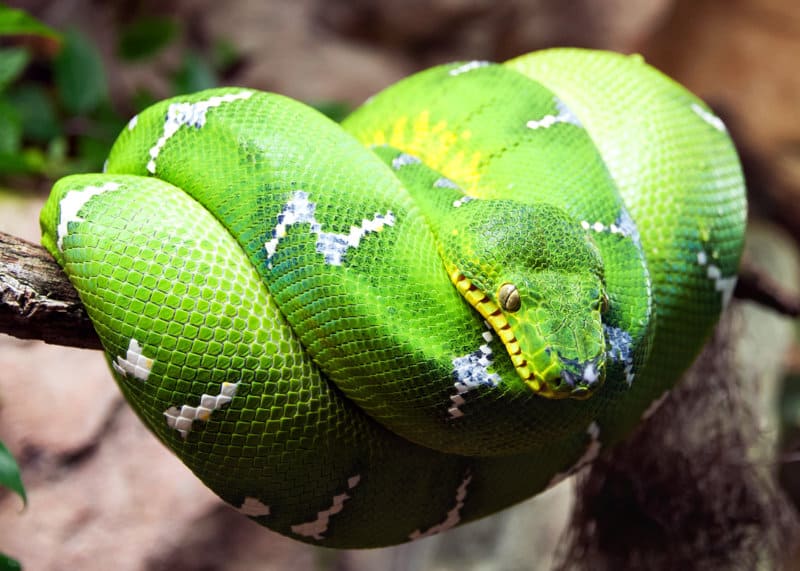
20. Common Sloth
The common sloth, scientifically known as Choloepus hoffmanni, is a sloth native to South and Central America. They live in the treetops of tropical rainforests.
They typically sleep, mate, and eat in the branches of trees. Common sloths come down to defecate on the ground every five days.

21. Raccoons
Raccoons are highly opportunistic animals. They have adopted life around humans and aren’t afraid to dig through human trash to find tasty food morsels.
The same carefree resourcefulness applies to their nesting sites as they nest anywhere provided they feel safe and comfortable.
22. Ducks
In the US, three varieties of ducks make use of cavity nests. They include:
- Barrow’s goldeneye ducks
- Baffle head ducks
- Common goldeneye ducks
Ducks in the tree cavities don’t take much care of their baby ducks. They leave their baby ducks to care for themselves shortly after hatching.
23. Minks
Minks are voracious carnivores. They eat just anything they can catch. Despite being highly aggressive towards other minks and even most other animals, they still nest together during the breeding season.
Minks make their nests inside fallen trees’ holes.
24. Nuthatches
The brown-headed and red-breasted nuthatches are tree cavity excavators. They prefer aspen trees for their nesting since aspens have softer wood than other conifers.
Although nuthatches prefer building new nests each year, they gladly reuse their nests if they must.
25. Pileated Woodpecker
A pileated is among the largest tree-dwelling birds. This bird measures about 15cm in length. Pileated woodpeckers are primarily found in North American deciduous forests.
They use their chisel-like bills to chip wood away to make their homes in tree trunks. They also drum on trees with their beaks to claim territory.
5 Adaptations for Tree Living
Animals require unique features and skill to living in trees.
Here are five features that allow these animals to live in trees successfully.
- Prehensile Tails: These tails act almost like a 5th limb, improving balance, climbing grip, and food gathering. For some animals, their larger tail also helps keep them warm in the trees. Monkeys, kinkajous, and chameleons have prehensile tails.
- Low Center of Gravity: Many tree-dwelling animals are stout and somewhat short-legged, especially compared to their ground-dwelling counterparts. Their lower center of mass improves balance and reduces the risk of falls. Examples include koalas and tree kangaroos.
- Gripping Feet: along with a low center of gravity, having feet that hold tight is a critical skill for tree-dwelling animals. Sharp claws, flexible joints (squirrels and possums), and sticky feet (tree frogs) help these animals grip trees and leaves.
- Gliding Membranes: The ability to glide between trees is a significant adaptation that makes tree life easier. Skin flaps and webbed feet allow for air transport. Gliding improves feeding and avoiding predators. Examples include flying squirrels, flying dragons, and flying lemurs.
- Swinging Arms: Animals like gibbons use brachiation (swinging) to move from tree to tree.
Final Thoughts
Many animals live in trees. Did I miss your favorite animal? Let me know in the comments what animal you love that lives in trees.
Drew Haines is an animal enthusiast and travel writer. She loves to share her passion through her writing.
She graduated high school at sixteen and started her own business, Everywhere Wild Media. And she runs Everywhere Wild and JustBirding. She also guest blogs on Storyteller.Travel
She lived in Ecuador for 6 years and explored the Galapagos Islands. Currently based in N.S., Canada.
